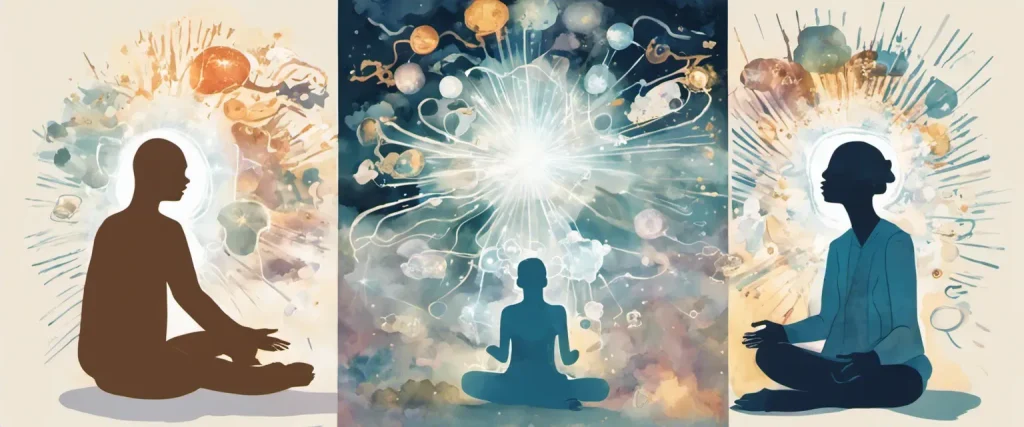In “You Can Heal Your Life,” Louise Hay presents a remarkable guide to transforming one’s life through the power of self-love and positive thinking. Drawing from her own personal experiences, Hay provides practical tools and insights to help readers overcome their inner struggles and create a life filled with joy, abundance, and well-being. As the author and advocate of self-healing, Louise Hay’s work has touched the lives of millions around the world, becoming a beacon of hope and inspiration for those seeking to improve their physical, emotional, and spiritual well-being.
Chapter 1: The Mind-Body Connection
Chapter 1 of “You Can Heal Your Life” by Louise Hay introduces the readers to the mind-body connection and the impact our thoughts and beliefs have on our physical health and well-being. Louise Hay promotes the idea that our thoughts and emotions play a significant role in the development of diseases and illnesses.
The chapter starts by highlighting the essential principle that the mind and body are interconnected, with our thoughts and emotions directly influencing the state of our physical health. Louise Hay explains that every thought we think and every word we speak creates our future and affects our body’s ability to heal itself. She emphasizes the importance of paying attention to our inner dialogue and being mindful of the messages we transmit to ourselves.
Hay presents various stories of individuals who have experienced remarkable healing by changing their thoughts and beliefs. She argues that ailments such as back pain, cancer, and even blindness can be attributed to deep-rooted emotional issues and negative thinking patterns. By addressing and resolving these emotional issues, healing and transformation can occur.
Moreover, she emphasizes the role of self-love and self-acceptance in maintaining good health. Louise Hay encourages readers to practice affirmations, positive self-talk, and forgiveness as powerful tools for self-healing and creating a healthy mindset.
In summary, Chapter 1 of “You Can Heal Your Life” introduces the concept of the mind-body connection and demonstrates the powerful impact of our thoughts and beliefs on our physical health. By becoming aware of our inner dialogue, practicing self-love, and adopting positive affirmations, individuals can enhance their healing abilities and lead healthier lives.
Chapter 2: Beliefs and Their Impact on Health
Chapter 2 of the book “You Can Heal Your Life” by Louise Hay examines the connection between our beliefs and their impact on our health. The chapter delves into the idea that our thoughts and beliefs contribute significantly to our overall state of well-being.
Hay introduces the concept that our minds, specifically our thoughts and belief systems, play a central role in creating our physical reality. Negative or limiting beliefs can manifest as physical ailments and disease. For example, if one constantly harbors feelings of self-criticism and low self-worth, it can manifest as illnesses such as migraines or stomach issues.
The author highlights the importance of taking responsibility for our own health and well-being through adopting a positive mindset. She emphasizes that our thoughts and beliefs are not fixed, and through awareness and conscious effort, we can transform negative beliefs into positive ones. The power of affirmations is introduced, as Hay suggests replacing negative thoughts with positive statements to reprogram the mind.
Hay also explores the impact of our childhood and upbringing on our beliefs and subsequent health. She encourages readers to investigate and release any ingrained negative beliefs that may have been acquired during childhood, as these can continue to affect our health in adulthood.
Overall, Chapter 2 of “You Can Heal Your Life” emphasizes the connection between our beliefs and our physical health. By recognizing and transforming negative thoughts, implementing positive affirmations, and releasing childhood conditioning, readers are empowered to take control of their health and create a more positive and vibrant life.
Chapter 3: Releasing Emotional Patterns
Chapter 3 of the book “You Can Heal Your Life” by Louise Hay, titled “Releasing Emotional Patterns,” delves into the connection between emotional patterns and physical ailments. Hay emphasizes that our emotions and thoughts have a significant impact on our overall well-being, and by uncovering and releasing deep-seated emotional patterns, we can heal ourselves.
The chapter begins by explaining that emotional patterns are closely tied to specific areas of the body, and emotions often manifest as physical symptoms or ailments. By observing and reflecting on our emotions, we can identify patterns that may be causing us harm. Hay introduces various emotional patterns associated with different body parts, such as anger being associated with the liver, fear with the kidneys, and resentment with the spleen.
She then outlines techniques to release these emotional patterns and heal the associated physical ailments. The first step involves acknowledging and accepting the emotions, as denial or suppression only perpetuates the issue. Hay suggests using affirmations, positive statements that counteract the negative emotions, to reprogram the subconscious mind. By repeating affirmations such as “I release all anger, and I choose to live with love in my heart,” individuals can gradually replace negative patterns with positive ones.
The chapter also emphasizes the importance of forgiveness, both towards oneself and others, as a crucial step towards emotional release and healing. Hay explains that holding onto grudges or resentment only perpetuates negative emotions and impacts our overall well-being.
In summary, Chapter 3 of “You Can Heal Your Life” explores the profound connection between emotional patterns and physical ailments. Louise Hay guides readers through the process of identifying and releasing these patterns by acknowledging emotions, using affirmations, and practicing forgiveness. By addressing these emotional patterns, individuals can significantly improve their well-being and overall health.
Chapter 4: Forgiveness and Self-Love

Chapter 4 of the book “You Can Heal Your Life” by Louise Hay focuses on the healing power of forgiveness and self-love.
Hay emphasizes that forgiveness is not about condoning someone’s actions or necessarily reconciling with them, but rather about freeing ourselves from the emotional burden and negative energy associated with holding grudges. She explains that holding onto resentment or anger only harms ourselves in the long run, impacting our physical, mental, and emotional well-being. Hay believes that forgiveness is a choice, a decision to let go of the past and create a better future.
To practice forgiveness, Hay suggests various affirmations and exercises that can help release negative feelings and resentments. She encourages readers to understand that people act based on their own beliefs and experiences, and that their actions are not a reflection of our worth. By forgiving others, we can release the emotional pain they may have caused and create space for more positive experiences in our lives.
Another crucial aspect of healing is self-love. Hay emphasizes the importance of treating ourselves with kindness, compassion, and acceptance. She believes that negative beliefs about oneself are at the root of many physical and emotional ailments. Through affirmations and self-love exercises, Hay invites readers to reframe their self-perception and cultivate a deep sense of love and acceptance for themselves.
Overall, Chapter 4 of “You Can Heal Your Life” highlights that forgiveness and self-love are transformative practices that can lead to personal growth, healing, and a more fulfilling life. By letting go of past grievances and embracing self-love, we can create a positive shift in our overall well-being.
Chapter 5: The Power of Affirmations
Chapter 5 of the book “You Can Heal Your Life” by Louise Hay, titled “The Power of Affirmations,” explores the transformative potential of affirmations in our lives. Louise Hay emphasizes that our thoughts and words carry energy, which can either support our well-being or hinder our progress. Affirmations are positive statements that we repeat to ourselves to reprogram our subconscious mind and create positive changes in our lives.
Hay delves into the concept that our present experiences are a result of past thoughts and beliefs. By becoming aware of our negative patterns and modifying our thinking, we can create a new and more fulfilling reality. Through constant repetition of affirmations, we can change our thoughts and beliefs, and ultimately open ourselves up to a universe of possibilities.
The author presents various real-life examples to showcase the healing power of affirmations. She emphasizes that affirmations must be used consistently and with conviction. She encourages readers to incorporate affirmations into their daily routines, using them as tools for healing, growth, and self-love.
Hay suggests that by regularly repeating positive affirmations such as “I am deserving of love,” “I am prosperous,” or “I am healthy and whole,” we can reprogram our subconscious mind, replacing old, limiting beliefs with empowering ones. Affirmations, she explains, help us let go of self-criticism, fear, and doubt, and shift our focus towards self-acceptance, love, and abundance.
Ultimately, Louise Hay believes that affirmations have the power to transform our lives by changing our thoughts and beliefs. By embracing the practice of affirmations, we can cultivate a positive mindset, create a healthier self-image, and open ourselves to a more joyful, abundant, and fulfilling existence.
Chapter 6: Healing Relationships
Chapter 6 of Louise Hay’s book, “You Can Heal Your Life,” explores the concept of healing relationships. Hay believes that our relationships mirror our beliefs about ourselves, and by changing our thoughts and limiting beliefs, we can transform and heal these relationships.
The chapter begins by acknowledging that all relationships are rooted in our relationship with ourselves. Our level of self-acceptance and self-love greatly influences our interactions with others. Hay emphasizes the importance of recognizing that we are all responsible for our own experiences and outcomes in relationships. She encourages readers to take accountability for their thoughts, emotions, and actions.
Hay identifies some common negative thought patterns and beliefs that hinder healthy relationships. These include fear of intimacy, abandonment issues, and the need for external validation. She invites us to release these limiting beliefs and replace them with positive affirmations and self-love.
The author also explores forgiveness as a vital tool for healing relationships. Hay introduces the concept of forgiveness as an act of self-love, explaining that holding onto resentment and anger harms us more than anyone else. By forgiving ourselves and others, we free ourselves from the burden of past negative experiences, enabling space for growth and healing.
Furthermore, Hay highlights the significance of communication and setting healthy boundaries in relationships. She encourages open dialogue, active listening, and expressing needs and desires honestly. Setting boundaries helps establish mutual respect and fosters healthier connections.
In summary, Chapter 6 of “You Can Heal Your Life” delves into the healing of relationships through self-acceptance, forgiveness, and effective communication. Hay provides insights and practical tools to rebuild and transform our relationships by letting go of limiting beliefs, embracing self-love, and taking responsibility for our experiences. Through these practices, she believes we can create and nurture more fulfilling and authentic connections with others.
Chapter 7: Creating a Prosperous Life
Chapter 7 of “You can heal your life” by Louise Hay is titled “Creating a Prosperous Life”. In this chapter, Hay addresses the concept of prosperity and teaches readers how they can create a life filled with abundance and wealth.
Hay starts by explaining that prosperity is not limited to financial wealth but encompasses all areas of life, including health, relationships, and personal fulfillment. She emphasizes the importance of recognizing and changing the limiting beliefs that may be blocking prosperity from entering our lives. Hay believes that our thoughts and beliefs create our reality, and by changing our mindset, we can attract abundance.
The author introduces various metaphysical principles and concepts to help readers create prosperity. She suggests using affirmations and visualization as powerful tools for reprogramming the subconscious mind to focus on abundance rather than lack. Hay also emphasizes the significance of gratitude, as expressing gratitude for what we have helps us attract more blessings into our lives.
Furthermore, Hay provides practical steps to manifest prosperity, such as setting clear goals, taking inspired action, and releasing any resistance or fears related to success. She encourages readers to follow their passions, trust in the process of life, and believe in their worthiness to receive abundance.
In conclusion, Chapter 7 of “You can heal your life” offers guidance on how to create a prosperous life by changing our thoughts, beliefs, and actions. Through affirmations, visualization, gratitude, and taking inspired action, readers can attract abundance in all aspects of their lives, ultimately leading to a more fulfilling and prosperous existence.

Chapter 8: Living in Alignment with Your True Self
Chapter 8 of Louise Hay’s book “You Can Heal Your Life” is titled “Living in Alignment with Your True Self.” In this chapter, Hay emphasizes the importance of self-acceptance and living authentically as a way to heal and improve our lives.
Hay explores how many of our problems stem from living inauthentically and not honoring our true selves. She believes that when we deny our true desires, feelings, and needs, it leads to emotional and physical imbalances, often resulting in various ailments and dis-eases.
To begin the journey of alignment with our true selves, Hay encourages readers to become aware of self-criticism and self-judgment, as these beliefs create disharmony within us. She suggests practicing self-love and replacing negative self-talk with positive affirmations to shift our mindset.
Next, she addresses the importance of setting boundaries and learning to say no when necessary. By doing so, individuals can create a life that is more in line with their authentic desires and values.
Hay also advocates for forgiveness and letting go of resentments and grudges, as holding onto negative emotions blocks personal growth and alignment with our true selves. She provides exercises and affirmations to help readers release past hurts and move forward with forgiveness and love.
The chapter concludes by emphasizing the importance of living in the present moment and embracing the journey of self-discovery. By cultivating self-awareness and honoring our true selves, we can live in alignment with our deepest desires and ultimately heal our lives.
After Reading
In conclusion, “You Can Heal Your Life” by Louise Hay is a transformative book that explores the power of the mind-body connection and provides practical tools for personal growth and healing. The author emphasizes the importance of self-love, positive affirmations, and releasing negative beliefs to create positive changes in one’s life. By taking responsibility for our thoughts and actions, and by practicing forgiveness and self-acceptance, Hay conveys the message that we all have the power within us to heal and create a fulfilling and joyful life. Her empowering teachings offer invaluable guidance for anyone seeking personal transformation and a journey towards self-love and happiness.
1. “How to Keep House While Drowning” by Kenneth Culp Davis
– This book offers practical advice and strategies for managing the challenges of daily life while feeling overwhelmed. Davis provides insightful tips on balancing responsibilities and maintaining mental and emotional well-being, making it a valuable resource for anyone struggling with life’s demands.
2. Your Erroneous Zones” by Wayne Dyer
– After reading “You Can Heal Your Life” by Louise Hay, “Your Erroneous Zones” complements it well by delving deeper into the concept of personal growth and self-improvement. Dyer presents practical techniques and exercises to help readers overcome self-limiting beliefs and live a more fulfilling life.
3. Being Mortal” by Atul Gawande
– In “You Can Heal Your Life,” Louise Hay emphasizes the importance of addressing our physical health and understanding our mortality. “Being Mortal” further explores this topic by exploring the realities of aging and end-of-life care. Gawande’s thought-provoking book teaches us to shape our lives and decisions in light of our mortality, fostering a deeper appreciation for the time we have.
4. The Gifts of Imperfection” by Brené Brown
– Building on the themes of self-acceptance and personal growth found in “You Can Heal Your Life,” Brené Brown’s “The Gifts of Imperfection” guides readers through embracing their authentic selves. With a focus on courage, compassion, and connection, Brown’s insights help individuals let go of societal expectations and cultivate a more wholehearted life.
5. Atomic Habits” by James Clear
– As “You Can Heal Your Life” emphasizes the power of positive affirmations and transformation, “Atomic Habits” is a perfect companion. Clear’s book unravels the science of habit formation and offers practical strategies for replacing negative patterns with positive ones. By creating small, sustainable changes, readers can build a foundation for personal growth and overall well-being.



